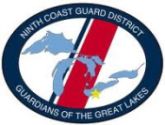
Black Sunday
November 9, 1913
On Sunday, the low pressure area was moving away from the lakes and, in many places, the snow had ended and the barometer was rising. Boats left port and ventured out onto the lakes with captains who probably believed that the storm had all but blown intself out, and knowing you can't make money by hiding in port whenever the weather turns a little ugly. They had no idea that they were about to encounter the deadliest storm in the entire history of Great Lakes navigation. It was during this lull that the 525 foot iron ore carrier Henry B. Smith sailed out of Marquette, not to be seen again for 100 years.
The weather was still fair at the foot of Lake Huron. The Regina had finished loading at Sarnia and, in the predawn hours, the Charles S. Price, Isaac M. Scott, John A. McGean, H. B. Hawgood and the Howard M. Hanna, Jr., passed Sarnia upbound carrying cargo and crew to a date with destruction and into the pages of Great Lakes history.
The Monster Arrives
A second low pressure system had formed overnight to the south and was missed by the morning weather report. By the time the evening weather report was sent the storm had almost a full day to build strength. Barometers plummeted as the storm intensified to hurricane proportions, its counter-clockwise winds shrieking as the monster pounced, raking its icy claws the length of Lake Huron. Hurricane strength winds of 90 mph drove blinding snow and sleet, piling waves into roaring black 40 foot moutains that mauled vessels and shorelines. Giant freighters were coated with sheets of ice; hurled against rocks and land as though nothing more than children's bathtub toys by deafening winds that screamed from one direction while mountain sized waves smashed at them from another. The greatest devastation of all was felt when twelve vessels lost their battle with the storm, going to the bottom with every soul aboard.
The Aftermath
The four day storm had destroyed communications all over the Great Lakes region. In Detroit eight feet snow drifts blocked the streets. At Cleveland the winds piled drifts so high that children were able to slide down them from second floor windows. Telegraph, telephone, electric and trolley wires were encased in ice and snapped under the strain. Damage to Port Huron, where trains were stalled and store windows smashed, was estimated at over $100,000. Fort Gratiot lighthouse was seriously undermined. At Milwaukee harbor the south breakwater was pounded to rubble and, at Chicago, the new breakwater was completely swept away in just a few hours. For several days many vessel owners had no knowledge of the whereabouts of their boats and crews. Prayers went into the storm for the safety of the crews but, for the families at home, each chime of the clock brought a growing certainty of their fate. As communication was gradually restored the true horror of the storm began to unfold as the list of vessel strandings and appalling losses grew at an alarming rate. Newspapers across the country reported a death toll that grew by the hour as bodies and wreckage came ashore, littering the entire southeastern shore of Lake Huron.
It only took 72 years to find the Titanic resting on the bottom of the North Atlantic, yet it took almost 100 years to locate the rusting remains of the 525 foot Henry B. Smith, lost with all hands after leaving Marquette just as the storm struck there. In July, 2015, the Hydrus was located 32 miles off shore in deep water. Two others, the Leafield and Plymouth, have never been found despite repeated attempts. The 504 foot Charles S. Price was found floating turtle thirteen miles northeast of Port Huron, where she lay as an unidentified “mystery ship”, her bow partially submerged, with the Revenue Cutter Morrill standing helplessly by as a silent guard to prevent other vessels from collision with her. It wasn’t until the 15th that her indentity, and the fate of her crew of twenty-eight, was confirmed. On May 26, 2025 the hull of the James C. Carruthers was located by shipwreck hunter, David Trotter, joined by the Underwater Research Associates, twenty miles off Harbor Beach, MI.
- VESSELS STRANDED -
- LAKE ERIE
- - C. W. Elphicke
- - Donaldson (barge)
- - Robert Fulton
- - G. J. Grammer
- LAKE HURON
- - Acadian
- - D. O. Mills
- - H. B. Hawgood
- - Howard M. Hanna jr. - (declared total loss but recovered)
- - J. M. Jenks
- - Lightship No. 61 (aka Corsica Shoals)
- - Matoa - total loss
- - Matthew Andrews
- - Northern Queen
- LAKE MICHIGAN
- - Halstead (barge)
- - Louisiana - total loss
- - Pontiac
- LAKE SUPERIOR
- - A. E. Stewart
- - Fred G. Hartwell
- - Huronic
- - J. T. Hutchinson
- - L. C. Waldo - total loss
- - Major - total loss
- - Scottish Hero
- - Turret Chief - total loss
- - William Nottingham, 3 lives lost
- St. CLAIR & DETROIT RIVERS
- - Saxone
- - Victory
- - W. G. Pollock
- St. MARYS RIVER
- - Meaford
- LAKE ERIE
- - Lightship No. 82, with crew of 6
- LAKE HURON
- - Argus, with crew of 28
- - Charles S. Price, with crew of 28
- - Hydrus, with crew of 25
- - Isaac M. Scott, with crew of 28
- - James C. Carruthers, with crew of 22
- - John A. McGean, with crew of 28
- - Regina, with crew of 20
- - Wexford, crew of 17-24
- LAKE MICHIGAN
- - Plymouth (barge), with crew of 7
- LAKE SUPERIOR
- - Henry B. Smith, with crew of 25
- - Leafield, with crew of 18
Near forty ships, over two hundred men
Sailed the lakes when the storm began
They fought the wind
And the mountain waves
But never came home again
These good ships torn
By the claws of the storm
And the white foam smothered the crew
And the wreckage washed
On the shores of the lakes
When the deadly gale was through
("Gale of 1913" - CD "It's Quiet Where They Sleep". ~ Lyricist: David O. Norris & Dan Hall, performed by Dan Hall)
- VESSELS FOUNDERED -
Nov. 6th | Nov. 7th | Nov. 8th | Nov. 9th
















